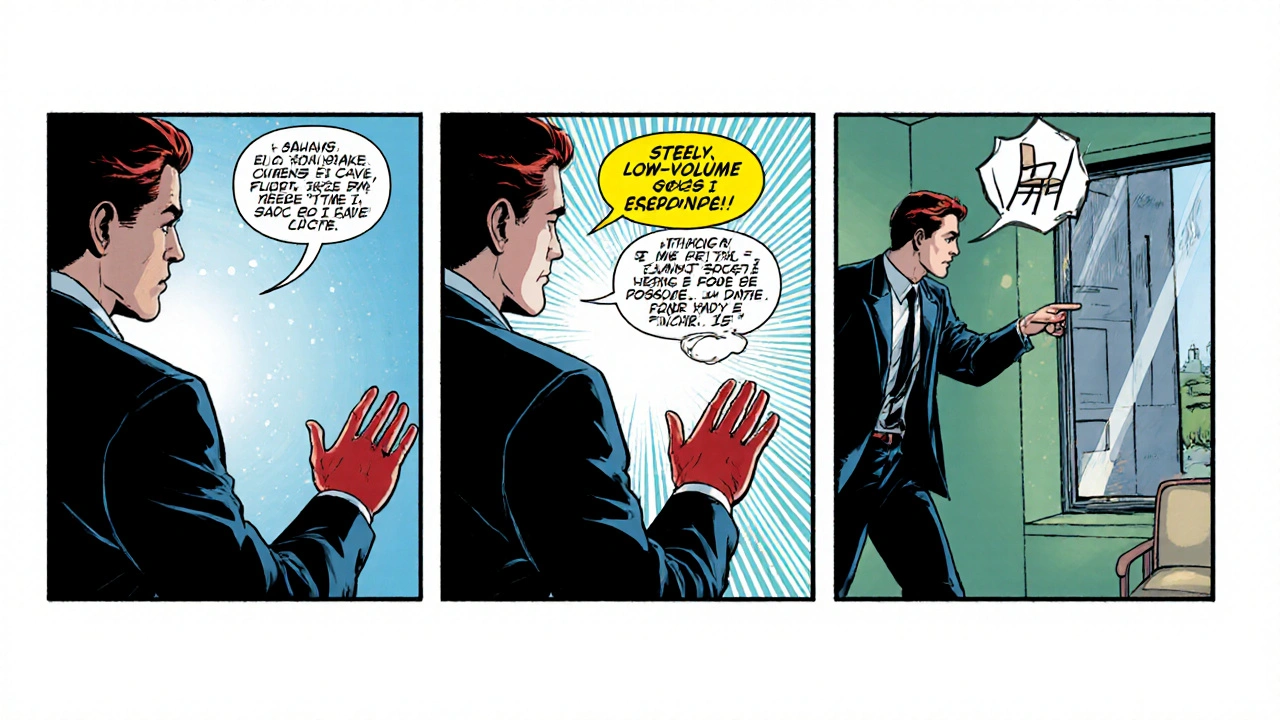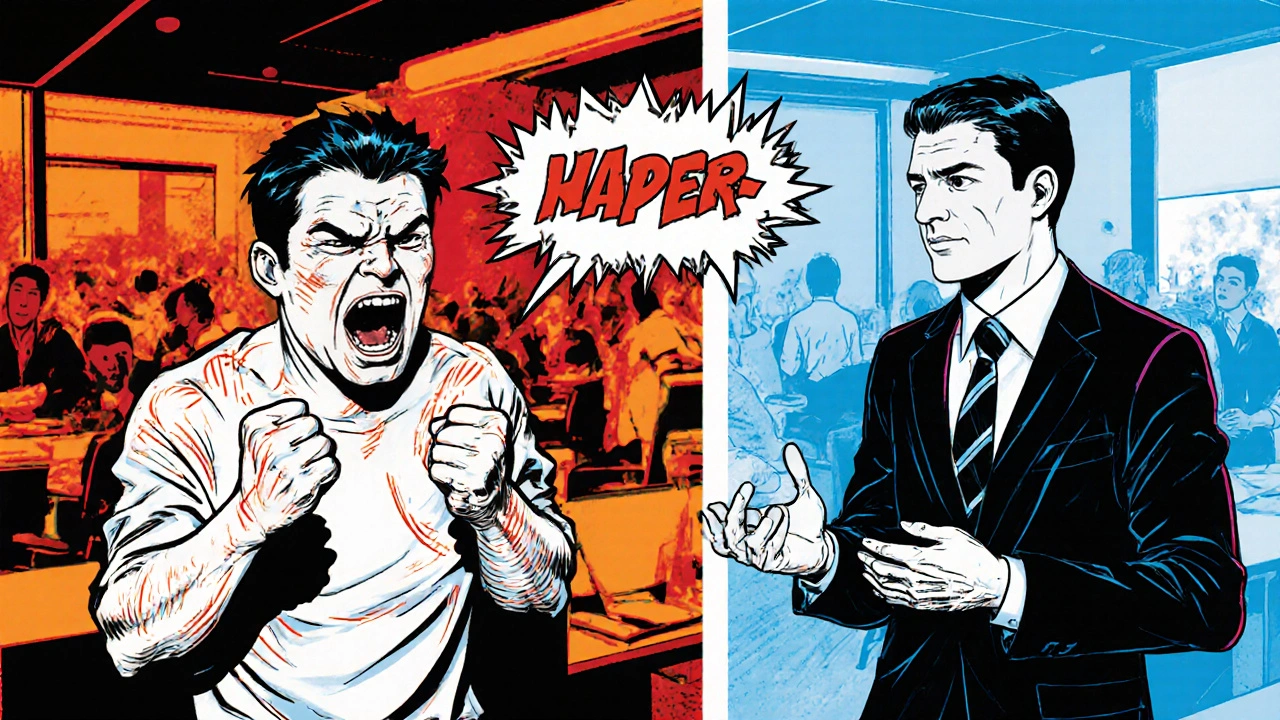When someone’s emotions are spiraling, a normal conversation can quickly turn into a showdown. Knowing how to stay calm, listen, and guide the exchange back to safety is a skill worth mastering. Below you’ll find practical steps, real‑world examples, and a handy checklist that can turn a heated moment into a constructive dialogue.
What Agitation Looks Like
First, recognize the signs. Agitated person is someone whose physiological arousal-fast breathing, clenched fists, raised voice-has pushed them into a heightened state of irritability or anger. Triggers vary: a sudden change, feeling threatened, or even low blood sugar can spark the response. Identifying the specific trigger the event or condition that sparks the agitation, such as loud noises or personal criticism helps you tailor your approach.
Core Principles That Keep the Conversation Safe
The foundation rests on three attitudes that work across cultures and settings.
- Empathy the ability to sense, understand, and share another person’s feelings - showing you’re on their side, not against them.
- Active listening fully concentrating, reflecting back what is heard, and asking clarifying questions - it lets the other person feel heard before you offer solutions.
- Validation acknowledging the person’s emotions as real and understandable, even if you disagree with their perspective - it cools down the fight‑or‑flight alarm.
When you blend these three, the agitated person’s stress response begins to drop, opening space for rational dialogue.
Step‑by‑Step Verbal De‑Escalation
- Pause and breathe. Give yourself a three‑second break before you answer; your tone will stay calm.
- Use a soft, steady voice. Volume and pitch signal safety; avoid shouting, which spikes adrenaline.
- Mirror key words. Repeat back words like “frustrated” or “overwhelmed” to show you’re tracking their feelings.
- Ask open‑ended questions. Instead of “Did you mean…?”, try “What’s making this situation feel so pressing for you?”
- Offer limited choices. People in a high‑arousal state regain control when they can pick between two calm options (e.g., “Would you prefer to talk here or step outside for a few minutes?”).
Each step is a micro‑interaction that builds safety. Skipping any of them can leave the conversation feeling rushed or dismissive.

Non‑Verbal Cues That Reinforce Calm
What you say is only half the message; body language carries the rest.
- Body language the posture, gestures, and facial expressions that convey openness or threat: Keep shoulders relaxed, avoid crossing arms, and maintain a neutral facial expression.
- Maintain eye contact at a comfortable distance-enough to show engagement but not to stare.
- Match the tempo of their breathing subtly; mirroring breathing can physiologically sync heart rates.
- Step back if you sense personal space is being invaded; a small physical gap can lower perceived threat.
These cues signal that you’re not a rival but a partner in solving the problem.
Setting Up a calm environment a physical and emotional space designed to reduce stimulation and promote relaxation
Sometimes the room itself fuels agitation. Simple adjustments can make a big difference.
- Turn down loud background noise - close windows, mute TVs, or relocate to a quieter spot.
- Control lighting - soft, indirect light reduces visual stress.
- Offer a glass of water or a seat - basic comfort gestures signal care.
- Remove potential distractions - put away phones or paperwork that could draw attention away.
- Set a clear time limit - “Let’s talk for the next ten minutes and then check in on how you feel.” gives structure.
When the environment supports calm, verbal strategies have a smoother path.
Do’s and Don’ts: Quick Comparison
| Do | Don’t |
|---|---|
| Speak slowly, keep volume low | Raise your voice or shout |
| Validate feelings (“I can see why you’re upset”) | Dismiss emotions (“You’re overreacting”) |
| Offer choices, not demands | Issue ultimatums |
| Maintain open body posture | Cross arms or point fingers |
| Take a short pause before responding | Reply instantly without thinking |

Common Pitfalls and How to Avoid Them
Even seasoned communicators slip up. Spotting these traps early saves the conversation.
- Assuming you know the cause. Jumping to conclusions can invalidate the person’s experience. Ask, “What’s on your mind?” before offering solutions.
- Getting defensive. If you feel attacked, you might mirror aggression. Take a breath, re‑center, and keep the focus on resolution.
- Over‑explaining. Flooding the person with facts can overwhelm them. Stick to concise, relevant information.
- Ignoring non‑verbal signals. A clenched jaw or shaking hands hint at lingering tension; address them directly (“I notice you’re biting your lip-are you feeling nervous?”).
Quick Checklist for the Moment
- Pause, breathe, and assess your tone.
- Identify the trigger and acknowledge it.
- Show empathy and validate the emotion.
- Use active listening - mirror words, ask open questions.
- Offer two calm choices.
- Adjust body language - open posture, soft eye contact.
- Modify the environment - lower noise, soften lighting.
- Check in after the exchange: “How are you feeling now?”
Frequently Asked Questions
How long should I wait before responding to an agitated person?
A brief three‑second pause is usually enough to collect your thoughts and lower your own voice level. If the person is extremely upset, extend the pause to five seconds and consider a simple statement like “I’m listening, please tell me more.”
What if my validation feels insincere?
Authenticity matters. Echo exactly what you heard (“You’re upset because the meeting ran late”) and add a genuine tone. If you’re unsure, say, “I can see this is frustrating for you, and I want to understand better.”
Should I ever walk away?
If safety is at risk, removing yourself is the right choice. State clearly, “I’m stepping out for a minute so we can both calm down,” then return when the person signals readiness.
Can I use humor to defuse tension?
Only if you know the person well enough to gauge that they’ll receive it as light‑hearted. Misplaced jokes can be seen as mockery, so start with gentle, neutral remarks.
What role does physical touch play?
Touch can be comforting for some, but for others it feels invasive. Ask first: “May I place a hand on your shoulder?” and respect a negative answer.

kevin joyce
July 17, 2025
When one contemplates the phenomenology of agitation, the lexicon of affect must be calibrated to the interlocutor's affective resonance; thus, the deployment of empathy is not merely compassionate but epistemologically requisite. By invoking a shared semantic frame, you embed your response within the same cognitive schema, allowing the agitated party to experience a sense of ontological validation. This praxis, while seemingly abstract, translates into concrete linguistic mirroring-repeating terms such as "frustrated" or "overwhelmed" to signal alignment with their affective landscape. Moreover, the utilization of active listening techniques, replete with reflective paraphrase, constructs a feedback loop that attenuates the amygdalar surge. Finally, the triangulation of validation, empathy, and choice offers a tripartite scaffold upon which de‑escalation can reliably be cultivated.
michael henrique
July 27, 2025
Cut the fluff and command respect through a decisive, low‑tone directive.
Jamie Balish
August 5, 2025
When you walk into a charged situation, the first thing you have to remember is that you are not there to win a debate, you are there to de‑escalate.
Your brain’s prefrontal cortex is still capable of regulating the amygdala only if you give it the breathing space it needs.
That’s why the three‑second pause isn’t a gimmick, it’s a neuro‑biological reset button.
Once you’ve hit that pause, lower your vocal register and adopt a cadence that mimics a calm river rather than a roaring waterfall.
Mirroring key words like ‘frustrated’ or ‘overwhelmed’ does more than show you’re listening; it signals that you’re mapping their affective state onto your own mental model.
Ask open‑ended prompts that start with ‘What’s happening for you right now?’ and you’ll often hear the underlying trigger that fuels the agitation.
Offering a binary choice-‘Would you like to step outside or stay here and continue talking?’-instantly restores a sense of agency.
If the environment is noisy, turn off the TV, close the blinds, and subtly dim the lights; sensory overload is a silent agitator.
Your body language should broadcast openness: shoulders relaxed, palms visible, and eyes softened to a gentle focus.
A light touch on the forearm can be grounding, but only if you have explicit permission, otherwise it’s perceived as invasion.
Remember to validate, not agree: ‘I can see why you’re upset about the deadline,’ not ‘I think the deadline is unreasonable.’
When the person calms, do a quick reality check: summarize what you heard and ask if that captures their experience.
That closure loop is what converts a volatile episode into a collaborative problem‑solving session.
If things still feel heated after your first pass, repeat the pause‑breathe‑listen cycle; mastery is built on repetition.
Finally, schedule a brief follow‑up later in the day to reinforce that the conversation mattered and that you care about the outcome.
All these micro‑steps together form a checklist you can keep on your phone, turning theory into habit.
michael abrefa busia
August 14, 2025
Totally agree, the checklist is gold! 😊
I’ve added a quick reminder on my phone and it’s saved a few heated moments already. 🌟
Keep spreading the word, it helps everyone stay calmer.
Dorothy Anne
August 23, 2025
Great rundown! I’ve found that the “pause, breathe, mirror” trio works wonders in my volunteer work.
Adjusting lighting and offering water really does signal care.
Thanks for the practical steps; I’ll definitely share them with my team.
Brufsky Oxford
September 2, 2025
Interesting take on neuro‑biology! 🧠
That three‑second pause aligns with the vagus nerve response, helping the body reset.
Remember to keep your tone soft; it’s a subtle cue the brain picks up instantly. :)
Keep the science coming!
Lisa Friedman
September 11, 2025
Actually the step about lighting is key, but you need to make sure the room isn’t too dim othrwise people might feel uneasy.
I think you also shuld mention the possiblity of offering a quick snack if low blood sugar might be a trigger.
Overall good guide but a few typos slip in the table.
cris wasala
September 20, 2025
Love the checklist its super useful and easy to remember when things get tense and you need a quick reference
Tyler Johnson
September 29, 2025
I appreciate the depth of the long‑form guide and want to highlight the importance of personal safety in any de‑escalation attempt. While empathy and validation are vital, they must not eclipse the need for clear boundaries when a situation threatens physical well‑being. If you sense escalation beyond verbal cues, stepping back and stating a brief pause can defuse tension without abandoning the conversation entirely. Moreover, it’s useful to have a pre‑planned exit strategy, such as a neutral third‑party mediator, prepared in advance for high‑risk scenarios. The integration of environmental adjustments, like reducing auditory stimuli, should be paired with a conscious control of your own breath to model calmness. Lastly, following up after the encounter reinforces trust and demonstrates that the interaction mattered beyond the immediate crisis.
Annie Thompson
October 9, 2025
That’s a solid reminder that safety isn’t optional it's a baseline requirement to any effective communication approach.
When we prioritize our own emotional regulation we give space for the other person to feel heard without feeling threatened.
Even a simple check‑in after the conversation can shift the lingering tension into a collaborative solution.
Thanks for emphasizing those practical safeguards.